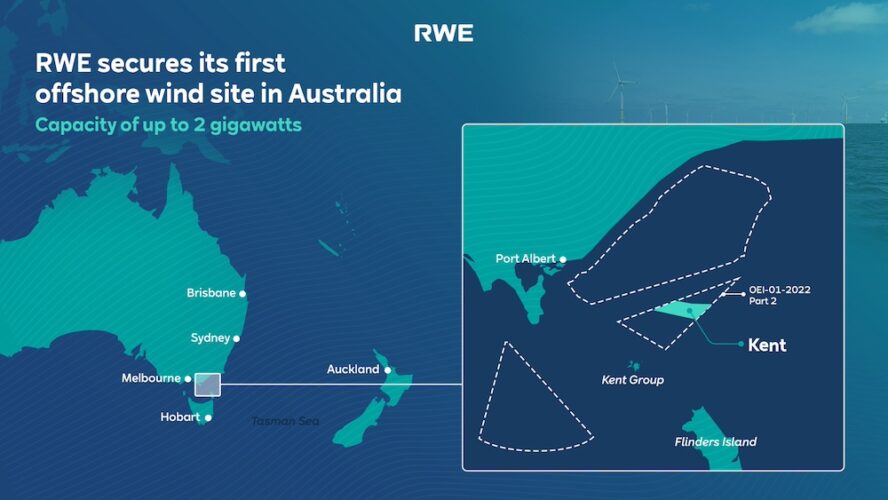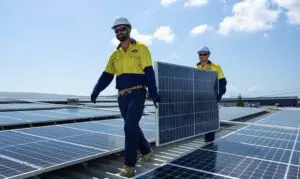A total of 10 offshore wind projects are now moving on to the next stage of development off the coast of Gippsland in Victoria, after another three projects were granted feasibility licences by the federal government this week.
Six offshore wind farms that were granted feasibility licences, outright, in May, and now four of an additional six projects also recommended for approval have been awarded their licences after further consultation. (See map below. Click to enlarge.) The winners include some of the world’s biggest energy companies and investors.
First out with the news, as we reported on Wednesday, was the 1.5GW Navigator North offshore wind farm being developed by RES and Origin Energy, proposed for an area of 700 km2, roughly 34 km off the Southern Australian coast.
That announcement was quickly followed by another three, as Australia’s first offshore wind development zone starts to fill out – although the journey for these developers is still at the very beginning.

The feasibility licences give the companies exclusive seven-year seabed rights to develop their project – including site and environmental investigations and community consultation – and to apply for a commercial licence to build and operate a wind farm.
Among those now taking that next step is Spanish outfit, BlueFloat Energy, whose up to 2.1GW Gippsland Dawn Offshore Wind project now has a licence to further explore its proposed development patch, located 10-33km from the coast between Paradise Beach and Ocean Grange.

Proposed area for the Gippsland Dawn Offshore Wind Project
BlueFloat says the feasibility licence will enable investigation work, including offshore metocean, geophysical and geotechnical investigations. Detailed technical studies and surveys will also be completed.
“Gippsland Dawn will bring strong and lasting benefits to Gippsland and Australia,” project director, Darragh White, said on Wednesday.
“We look forward to continuing our engagement with Minister Chris Bowen, Victorian Energy Minister Lily D’Ambrosio, GLaWAC, local communities, unions and the energy industry in Victoria.
“We will work closely with commercial and recreational fishers and boaters to understand how we can share the ocean,” White said.
BlueFloat Energy CEO Carlos Martin says the licence award is a testament to the company’s commitment to pioneering renewable energy projects in Australia and its leadership in the offshore wind sector.
“BlueFloat Energy is one of the most successful offshore wind developers: founded in 2020 and having built a global pipeline of over 34 GW since then,” Martin says.
“This milestone will pave the way for significant advancements in new energy, supporting the transition away from traditional coal-fired generation to new offshore wind, which will benefit both the environment and the communities we serve in Victoria and wider Australia.”
Also granted a feasibility licence this week is the up to 2GW Kent Offshore Wind Farm proposed for development in the Gippsland zone by German renewables giant RWE.
The RWE site is about 67km off the coast and has average water depths of 59 metres, the company says. It is hoping to have the wind farm operational in the first half of the 2030s, “subject to the timing of the planning and approvals process, secured offtake as well as grid connection.”

RWE-Australia-Kent offshore project 2024
“Australia is a very attractive growth market for renewable energy,” said Sven Utermöhlen, CEO of RWE Offshore Wind, in a statement on Wednesday.
“By securing exclusive seabed rights in the Bass Strait off Gippsland, we are now entering the Australian offshore wind market and will bring our more than 20 years of experience in this field.”
RWE currently operates 19 offshore wind farms, globally, including more than 4GW that are currently under construction in Europe.
In Australia, based out of Melbourne, RWE company has been around for 10 years building a portfolio that includes the 249MW Limondale solar farm in New South Wales.
The company plans to invest around $A6 by 2030 to develop up to 3GW of wind, solar and battery projects across the country and, last year, was awarded a Long-Term Energy Service Agreement to deliver and operate Australia’s first eight-hour battery adjacent to Limondale.
In a statement, RWE says the next step for the Kent Offshore Wind Project is to carry out studies to help determine the project design and to submit applications for planning permission.
RWE will also engage with key stakeholders, First Nations groups and other communities. Another key milestone in the project’s development at a later stage is to secure an offtake agreement.
A licence has also been awarded to the 2.5GW Great Eastern Offshore Wind project, which is being developed by Macquarie offshoot Corio Generation around 22km off the central Gippsland coast to the east of Wilsons Promontory.
In a statement, the company says it can get on with the detailed assessment works needed to progress the project to a commercial stage, with an eye to having it up and running in 2032 “to meet Victorian state targets.”
“Our Victorian team combines extensive international experience in delivering world-class offshore wind farms with strong local knowledge and capabilities,” said Corio Generation CEO John Cole in a statement on Wednesday.
“Great Eastern Offshore wind will contribute to Australia’s energy transition and journey towards net zero.”
Corio says the project team has undertaken significant community and stakeholder engagement since 2021 and will continue to work with all stakeholders, including governments, local communities, and First Nations peoples in the forthcoming phases of the project.
“The project has recently achieved a milestone by completing 17 months of a 24-month marine environmental baseline survey program to inform the project development,” a statement says.
“Great Eastern Offshore Wind will be tapping into the region’s existing skills and experience from local industries to support the development, construction and operation of the project.
“A major aspect of the project will be to build local capacity and generate long-lasting benefits for local communities for years to come.”
Another two projects – Ørsted 2 and Iberdrola’s Aurora Green – are expected to announce their own updates on a feasibility licence for the Gippsland zone. More to come.








